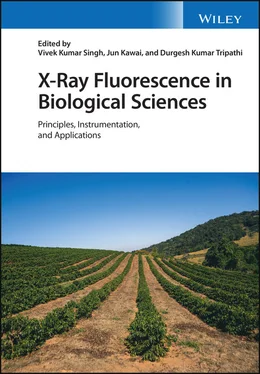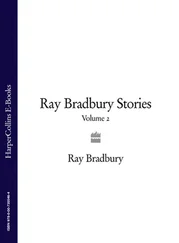X-Ray Fluorescence in Biological Sciences
Здесь есть возможность читать онлайн «X-Ray Fluorescence in Biological Sciences» — ознакомительный отрывок электронной книги совершенно бесплатно, а после прочтения отрывка купить полную версию. В некоторых случаях можно слушать аудио, скачать через торрент в формате fb2 и присутствует краткое содержание. Жанр: unrecognised, на английском языке. Описание произведения, (предисловие) а так же отзывы посетителей доступны на портале библиотеки ЛибКат.
- Название:X-Ray Fluorescence in Biological Sciences
- Автор:
- Жанр:
- Год:неизвестен
- ISBN:нет данных
- Рейтинг книги:5 / 5. Голосов: 1
-
Избранное:Добавить в избранное
- Отзывы:
-
Ваша оценка:
- 100
- 1
- 2
- 3
- 4
- 5
X-Ray Fluorescence in Biological Sciences: краткое содержание, описание и аннотация
Предлагаем к чтению аннотацию, описание, краткое содержание или предисловие (зависит от того, что написал сам автор книги «X-Ray Fluorescence in Biological Sciences»). Если вы не нашли необходимую информацию о книге — напишите в комментариях, мы постараемся отыскать её.
Discover a comprehensive exploration of X-ray fluorescence in chemical biology and the clinical and plant sciences X-Ray Fluorescence in Biological Sciences: Principles, Instrumentation, and Applications
X-Ray Fluorescence in Biological Sciences: Principles, Instrumentation, and Applications
X-Ray Fluorescence in Biological Sciences — читать онлайн ознакомительный отрывок
Ниже представлен текст книги, разбитый по страницам. Система сохранения места последней прочитанной страницы, позволяет с удобством читать онлайн бесплатно книгу «X-Ray Fluorescence in Biological Sciences», без необходимости каждый раз заново искать на чём Вы остановились. Поставьте закладку, и сможете в любой момент перейти на страницу, на которой закончили чтение.
Интервал:
Закладка:
Confirmed the remark of Debastiani et al. [85] about significant differences in concentrations of certain elements between coffee samples of different brands and between different batches of the same brand.
K, Mg, P, Ca, and S proved to be elements with a higher concentration in Brazilian coffee.
Analysis of spent coffee showed that the extraction coefficients are specific for each element (the highest extraction coefficients from ground coffee are obtained for Cl and K, then Rb and P).
Paper filters do not transfer elements to coffee beverage.
3.6 Determination of the Elemental Composition of Krasnodar Tea Samples by TXRF and WDXRF
The paper Maltsev et al. [88], analyzed samples of several varieties of Krasnodar tea. This tea is the singular Russian tea product, the chemical composition of which was here studied for the first time. In practice the contents of 16 elements from phosphorus to lead have been determined. Nineteen commercially available samples of Krasnodar tea have been investigated. Table 3.4shows the name, type, shape, and quality of each tea according to producer information on the package. Krasnodar tea plantations are the northernmost of all tea plantations in the world. Tea in the Krasnodar region has been grown since the beginning of the twentieth century. The first attempts to grow tea bushes brought from China proved unsuccessful. In the harsh winter, the bushes died. Only seeds brought from Georgia managed to grow tea. The first tea plantation appeared near the city of Sochi, in a valley of mountains 220 m above the sea. The history of Russian tea breeding began with this plantation. The tea qualities “granulated”, “long leaf,” and “packed” are common in the classification of tea quality.
One of the original types of Krasnodar tea is a skull tea. It is produced by two enterprises: Dagomys Chai Group of Companies and Matcsestin Tea Factory. It includes shank, stem particles, and tea leaf. This tea does not belong to the varieties of tea, but it is not inferior to other types of Krasnodar tea. In fact, in some parameters it exceeds many granulated and packaged varieties. Skull tea can be stored longer than usual. It is necessary to note that in Japan tea is also made from shank and thin stems of tea bush. It is called kukicha. Raw materials that are used in the production of skull tea undergo the same treatment as other parts of the plant. Based on the kind of treatment and fermentation, a green or black skull tea is obtained.
Table 3.4 Description of analyzed tea samples from Krasnodar.
| Code of a sample | Tea type | Name and origin |
|---|---|---|
| A1 | Black granulated tea, first grade | Azerchai, “Kuban‐Tea”, Krasnodar region, Belorechensk |
| A2 | Tea black long leaf “Bouquet” | |
| A3 | Tea Green Superior Grade, packed | |
| A4 | Tea black “Bouquet,” packed | |
| A5 | Tea Black Superior Class “Peko” | |
| D1 | Tea black skull (petiolar) | Dagomys Chai, Krasnodar region, Sochi |
| D2 | Green long leaf (Bayh) Tea “Extra” | |
| D3 | Black long leaf Tea “Extra” | |
| D4 | Black long leaf tea № 36 | |
| D5 | Tea black “Extra” packed | |
| D6 | Green tea packed | |
| M1 | Tea black classic “Selection” packed | Matcsesta Tea Factory, Matcsesta, Sochi, Izmailovka village |
| M2 | Tea green classic “Selection” packed | |
| M3 | Tea black classic “Bouquet” | |
| M4 | Tea green classic “Bouquet” | |
| M5 | Tea black long leaf “Kazachok” | |
| M6 | Petiolar green tea | |
| M7 | Tea black skull (petiolar) | |
| С1 | Tea black long leaf classic | Krasnodar since 1901, Sochi, Solokhaul village |
3.6.1 Instrumentation
The main studies were carried out with the TXRF spectrometer S2 PICOFOX (Bruker, Germany) with a 50 W X‐ray tube and Mo‐anode, multilayer monochromator (Ni/C), and silicon‐drift detector (SDD) with energy resolution ~150 eV. Measurements of analytical line intensities for all elements were performed at 50 kV X‐ray tube voltage and 500 μA current. The material prepared for analysis was applied to quartz substrates. All measurements are made in air.
A S4 Pioneer (Bruker, Germany) WD X‐ray spectrometer with a power of up to 4 kW with a Rh anode and a 75 μm thickness Be window was used. When the atoms P, S, Cl, and K were excited, the voltage on the X‐ray tube was 30 kV, the current was 60 mA, and the measurement time was twenty seconds. In time measurement the intensity of the analytical Kα lines of Ca, Ti, Mn, Fe, Ni, Cu, Zn, Rb, Sr, and Lα for Ba, a voltage of 50 kV and a current strength of 40 mA was used. The signal recording time for Ca, Mn, Fe, and Sr was twenty seconds, for Ba ‐ fourty seconds and for the remaining elements ‐ thirty seconds. The analyzing crystals used were PET for P, S, and Cl, and LiF 200 for the remaining elements. All measurements were made in a vacuum.
3.6.2 Suspension Preparation
To prepare the suspension, 2.0 ml of distilled water, an internal Ga standard with a final concentration in the dry residue of 100 mg/kg, was added to 20 mg of pre‐dried (at 85 °C for four hours) and overloaded tea leaves in the agate mortar, and mixed thoroughly. Next, 10 μl of suspension was applied to a quartz substrate, dried, and measured for five hundred seconds.
3.6.3 Infusion Preparation
The standard tea preparation procedure indicated on the package was reproduced. When brewed, 240 mg of tea leaves were placed in special bakes, poured with 30 ml of distilled water (temperature ~90 °C). After 5–7 minutes, 1 ml of solution was taken. Then, 100 μl of 100 mg/l internal Ga standard was added and thoroughly mixed before 10 μl was applied to a siliconized quartz glass carrier and dried. The measurement time of the sample was five hundred seconds.
3.6.4 Acid Digestion
10 mg of ground and dried tea leaves were placed in a special glass tube. 1 ml of concentrated nitric acid and 50 μl of hydrogen peroxide were added and heated in an oven until fully evaporated. At the end of the process, 200 μl of 10% HNO 3, 20 μl of 100 mg/l internal Ga standard were added and mixed thoroughly. 10 μl of the resulting solution was placed to a quartz carrier, dried by infrared radiation and measured for five hundred seconds.
3.6.5 Preparation of Samples for WDXRF
Samples were pressed as a tablet on a boric acid substrate using a semiautomatic hydraulic press. For this purpose, about 1 g of tea leaf powder was crushed in an agate mortar. Next, 0.5 g of the resulting material was pressed into tablets at a force of 18 tons.
3.6.6 Results and Discussion
The results show that particles of the samples prepared via acid decomposition were uniformly distributed on the quartz carrier. Non‐uniform distribution of large particles of different shapes over a carrier surface is registered for sample prepared from suspension. The authors found that analysis of the sample suspension is a fast and simple procedure for the targeted determination of elements such as Ca, Mn, Cu, Zn, Br, Sr. Possible explanations for the inaccurate information on elements with small atomic numbers (P, S, and K) are explained by the differences in effects of absorption by the tea matrix, confirmed by studies of samples of biological origin [13, 89]. In addition, for P, S, and K, the effect of inhomogeneity in the sample distribution on the carrier was more significant when the suspension was used. It should also be noted that the determination of Cl and Br using the acid decomposition method is difficult due to the volatility of these elements, and therefore the use of suspension is recommended for them. The best measurement results for most elements are obtained by analyzing solutions after acid decomposition of tea leaves, whereby this sample preparation method is used to analyze samples of Krasnodar tea. To determine Cl and Br, samples were prepared as suspensions. The average value of the relative standard deviation of the analysis results from the certified values of the CRM for the method used in the verification was not more than 6% for Mg, P, S, Mn, Ni, Cu, Zn, Br, Rb; for K, Ca, Sr, Ba, and Pb – not more than 16%. The largest discrepancies were obtained by determining Ti and Fe. The total uncertainty of TXRF results, considering all stages of analysis (sample preparation and measurement), for all elements except for Ti was on average no more than 16% (n = 3). The uncertainty of applying a sample onto the carrier averaged 7% (n = 7).
Читать дальшеИнтервал:
Закладка:
Похожие книги на «X-Ray Fluorescence in Biological Sciences»
Представляем Вашему вниманию похожие книги на «X-Ray Fluorescence in Biological Sciences» списком для выбора. Мы отобрали схожую по названию и смыслу литературу в надежде предоставить читателям больше вариантов отыскать новые, интересные, ещё непрочитанные произведения.
Обсуждение, отзывы о книге «X-Ray Fluorescence in Biological Sciences» и просто собственные мнения читателей. Оставьте ваши комментарии, напишите, что Вы думаете о произведении, его смысле или главных героях. Укажите что конкретно понравилось, а что нет, и почему Вы так считаете.











